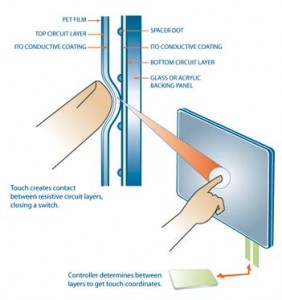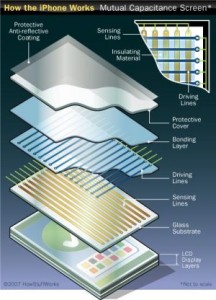Smart screen interfaces - Case Study
Touch screen mobile devices for display and interaction are a growth area.
As a case study, summarise how the interface works from your investigations.
Touchscreen displays, as their name suggests, are responsive to touch and capable of sensing the presence and location of any touch within their display areas. These displays can sense passive objects such as a stylus or active objects such as fingers or hands. There are different types of technology used in touchscreens but the most common types are resistive and capacitive.
Resistive touchscreens have two flexible sheets coated with resistive
with resistive
material and separated by an air gap or microdots. When contact is made to the surface of the touchscreen, the two sheets are pressed together and a precise location is registered for the touch occurring on the display. Resistive touchscreens are described as “passive” technology as they sense input from contact with nearly any object.
 Capacitive touchscreens are glass with a thin, transparent metallic coating. They have a built-in electrode pattern charging the screen. When the display is touched, a current drawn to the finger creates a voltage drop. The exact location of the voltage drop/touch is picked up by a controller and transmitted to a computer. Capacitive touch screens are commonly found in interactive building directories and more recently in Apple’s iTouch technology.
Capacitive touchscreens are glass with a thin, transparent metallic coating. They have a built-in electrode pattern charging the screen. When the display is touched, a current drawn to the finger creates a voltage drop. The exact location of the voltage drop/touch is picked up by a controller and transmitted to a computer. Capacitive touch screens are commonly found in interactive building directories and more recently in Apple’s iTouch technology.

Ricky
February 10th, 2015 at 06:23
warning@boliou.enjoyed” rel=”nofollow”>.…
ñýíêñ çà èíôó!…
troy
February 11th, 2015 at 11:43
lura@pete.exalting” rel=”nofollow”>.…
áëàãîäàðåí….
Dwight
February 12th, 2015 at 23:07
tentatively@stampede.openly” rel=”nofollow”>.…
ñïàñèáî çà èíôó….